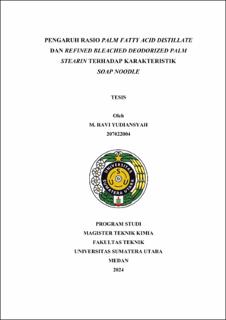Pengaruh Rasio Palm Fatty Acid Distillate dan Refined Bleached Deodorized Palm Stearin terhadap Karakteristik Soap Noodle
Effect Of The Ratio of Palm Fatty Acid Distillate and Refined Bleached Deodorized Palm Stearin on Characteristics Soap Noodle

Date
2024Author
Yudiansyah, M. Ravi
Advisor(s)
Hasibuan, Rosdanelli
Tambun, Rondang
Metadata
Show full item recordAbstract
Soap noodles, also known as soap pellets, are raw materials for making soap and
are obtained through the saponification of vegetable oil. Physically, soap noodle
is a cylindrical extrusion result, with a white to cream color, and have a melting
point of 70-80 °C. Generally, soap noodles are produced from palm oil. Soap
noodles production is also done by mixing two types of oil or fat with a specific
ratio called an oil blend. The mixture of several vegetable oils has the potential to
change the physicochemical properties of the oil and, therefore, can change the
technofunctionality of the final product to provide the desired properties.
Therefore, optimization needs to be done to achieve the desired product quality.
Oil blend as a raw material in soap noodles production can be made by mixing
the Palm Fatty Acid Distillate (PFAD) with Refined Bleached Deodorized Palm
Stearin (RBDPS). This study aims to (1) analyze the effect of the ratio of
PFAD:RBDPS on the characteristics of soap noodles; (2) analyze the effect of
Total Fatty Matter (TFM) on the characteristics of the resulting soap noodles. In
this study, the PFAD:RBDPS ratios were 10:90, 30:70, 50:50, 70:30, and 90:10,
with TFM used at 50% and 60%. The saponification process was carried out with
a total mass mixture of 1,000 g, a stirring speed of 400 rpm, and a reaction
temperature of 80 °C. The results showed that the PFAD:RBDPS ratio and TFM
affected the characteristics of soap noodles. Increasing the amount of PFAD will
increase 48% NaOH solution’s need to make soap noodles. The best soap noodle
was obtained with a PFAD:RBDPS ratio of 70:30 and TFM of 60%, with a
moisture content of 23,48%, a free alkali content of 0.32%, a salt content of
0.99%, an alcohol-insoluble matter of 7.08%, a glycerol content of 3,04%, and
hardness of 22 mm/s.
Collections
- Master Theses [142]
